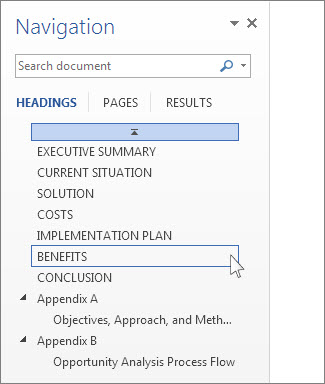
If you save a Word document as an HTML file to be published on the web, Word automatically and correctly translates text formatted with the built-in Heading styles as H1, H2 etc. A basic element of HTML is to label headings as H1, H2 etc. The standard language for publishing documents on the web is HTML. But at least it's still there!) Publishing to the web (If you try to delete a built-in Heading style, Word just re-sets it to the default. Word won't let you delete the in-built Heading styles, so it helps to protect you and keep the document stable. That means you have to go back and re-create the numbering from scratch.
#How to choose heading styles in word 2010 how to
You can create a custom style and number it using the techniques given in How to create numbered headings in your Word document.īut if you accidentally or deliberately delete a custom style that was part of an outline numbering scheme, the whole numbering scheme can collapse. TIP: The Word add-in DocTools CrossReferenceManager can help you createĬross-references to captions, headings and other types of targets more efficiently So you may as well use the built-in Headings styles and the built-in caption functionality to start with.

So even though you can create your caption numbers without using Word's caption functionality, you can't refer to the captions without the built-in caption functionality (unless you create a complex system of bookmarks). The only labels listed there are those either built-in or created in the Insert Caption dialog.

If you want to refer to captions in your document (for example "see Figure 1-4, on page 12, above"), then the label (in this case "Figure") must appear in the Insert Cross-reference dialog. But it only works with Word's built-in Heading styles (Figure 1).įigure 1: When you go to add "chapter" numbering to captions, the only available styles are the built-in heading styles. In the Caption dialog, you add the chapter number by clicking Number and choosing which style to use for the "chapter" number. In Word 2007 and Word 2010, it's at References > Insert Caption. In Word 2002 and Word 2003, it's at Insert > Reference > Caption. But it's a lot easier to use Word's built-in caption functionality. There are several ways to create captions for your figures or tables so they look like "Figure 1-4" or "Table 2.3". See How to control the page numbering in a Word document at the MS Word MVP FAQ site for a description of how to control page numbering in both simple and quite complex ways. See I want to include the chapter number with the page number in the Header – how can I do this? on the MS Word MVP FAQ site for a description of how to do page numbering like this (and several good reasons why you might not want to!). But the numbers won't appear properly in your Table of Contents unless you use Word's built-in heading styles. Let's say you want your page numbers to look like -4 or. But Word makes it easier if you use the built-in Heading styles, because they are the default. You can use any styles to construct a Table of Contents. See How to apply a style in Word for a list.

It is particularly easy to apply the built-in Heading styles because Word has built-in keyboard shortcuts. But Word makes it easier to apply numbering to the built-in Heading styles. You can apply numbering to any kind of style. If you don't like the format of the built-in styles (and few people would find them attractive as they arrive out of the box), you can modify the styles so they have the font, paragraph and other formatting you want. But there are good reasons to use Word's built-in Heading styles. You can use other styles (including your own custom styles) for most heading and numbering purposes. They are called Heading 1, Heading 2 etc. You can do almost any task of numbering using your own custom styles.īut there are over a dozen good reasons to use the built-in Heading styles and modify them to suit your needs.


 0 kommentar(er)
0 kommentar(er)
